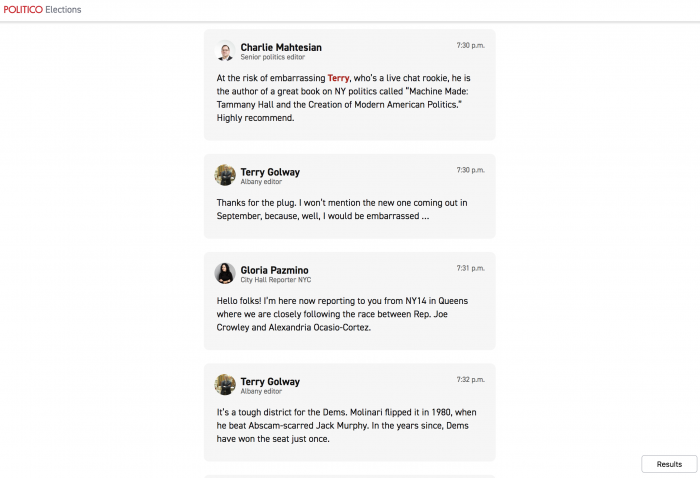
Do you ever wish you could be a fly on the wall of someone else’s Slack channel?
FiveThirtyEight fans can read its Slack-like conversations, adding statistical context to current events since 2015 (which political party would be more likely to survive the apocalypse, for example). The New York Times, the Los Angeles Times, and others have been orchestrating similar chats since then, too. But if you’re a local political diehard just trying to follow along with the experts on an election night — and you don’t want John King’s Magic Wall on CNN or local TV reporters reporting from hyped watch parties — Politico’s Slack chat set up could be just the ticket.(And psst, it’s open source, so you can use it for your own newsroom, too.)
Since the spring primaries, and continuing every Monday night through the midterms in November, as well as every Tuesday when there’s a primary election, Politico reporters gather on a Slack channel that links their messages to the outside world with the aforementioned code spun up by McClure and the interactive news team. Audience members don’t have to make their own Slack account or join the workspace, but during an election night they can toggle back and forth between the results page and the conversation, piping in with their own questions over Twitter. It’s like the readers going to a watch party or trivia event, but with less effort — perhaps literally by staying at home.
Jon McClure, who joined Politico as the interactive news editor from the Dallas Morning News last year, was fascinated by the brain exchange happening at the editorial meetings and elsewhere in the newsroom. He wanted to bring those same insights to readers, especially on a slow election night.
“People come in for the live results which they want, but live results aren’t constantly ticking throughout the night,” McClure said. “So we encourage them to hop over to our Slack chat and hang out with us there, as we’re providing context in between new results coming in. We’re trying to supplement that live results experience, and we’re seeing those pages feed each other.”
They started building in February, open sourced the code in March, and ran the first election night Slack chat with the Illinois primary on March 20.
The chat is politica, but it’s also slightly restrained. No more than 10 Politico journalists are involved in a single chat; there’s also always an emcee at the helm to keep the conversation on course and clarify any side references (or inside jokes). I happened to watch (read?) the first one live, and there was some cross-talk and responses out of order, but still an impressive amount of proper grammar and punctuation for a Slack chat. It felt like I was observing a group text that actually taught me something with its analysis, and since it was about local elections — not 2016 or 2020, or even last year’s nationally watched Alabama senatorial race — it seemed like a more relatable, close-knit experience as well.
At its core, the Slack chat is about journalists providing context to the rolling-in results — vamping with Twitter-submitted reader questions when there weren’t any. The emcee or a social team member sourced a few from the Twitter hashtag, and the journalists happily took the bait and dug into the wonkiness of election night. “This isn’t where we’re breaking news but it’s where we’re knitting together the news we broke ahead of time and give you more of a layman’s understanding of the news,” McClure said.
As much as 20 percent of the audience on election nights were circulating between the results page and the live chat page, he added.
Politico has been testing this with both election night live events and its Midterm Monday topical deep dives (“Do voters really pick the winners of Democratic primaries?”). “When we started, we said we can knock one of these out in 30 minutes, but the reality is you need 45 minutes to an hour for good conversation,” McClure said. “The hard thing, early on was making sure they are succinct and that they consolidated around a central question.”
But in addition to the live, planned events like an election night and the routine events like the Monday series, this could also unfold into breaking news, once Politico equips the newsroom with the ability to pull one up at a few clicks of a button at any time of day.
“Our newsroom looks at it as one tool, but we want it to be one tool that creates several distinct types of content,” McClure said.